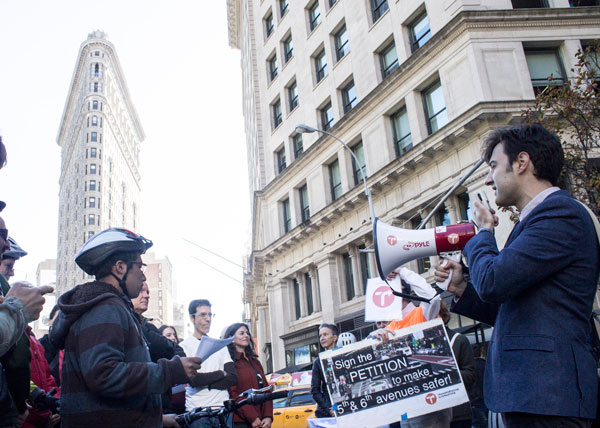
BY ZACH WILLIAMS | About three dozen transportation activists made their way through Chelsea and the West Village on Sun., Oct. 19, to support businesses in favor of redesigning Fifth and Sixth Aves. as so-called “complete streets.”
The city’s Department of Transportation is studying Fifth and Sixth Aves. for possible redesigns to better integrate bicycle, automobile and pedestrian traffic.
Activists from Transportation Alternatives did a neighborhood walk-through in support of the initiative. More than 20 small businesses along the corridor gave out discounts and freebies to participants.
A petition urging the department to conduct the study gathered more than 15,000 signatures in support of the two-year effort.
Streets that have been redesigned to include separate space for cars, bikes and pedestrians (and sometimes buses) have resulted, on average, in a 20 percent decrease in accident rates citywide, according to Tom DeVito, T.A.’s Manhattan organizer.
He said a study of Fifth and Sixth Aves. shows how such initiatives are moving in from the Manhattan periphery.
“They’re right down the center of Manhattan, where everybody is, where densities of pedestrians are the highest of the city, and density of cyclists are the highest in the city,” said Albert Ahronheim, chairperson of the T.A. Manhattan Activist Committee. “And put cars together in that mix and you have two avenues with the highest rates of injury in the city.”
Retail sales increased by as much as 49 percent for Ninth Ave. businesses between 23rd and 31st Sts. following the avenue’s redesign, according to a recent D.O.T. report (“Measuring the Street: New Metrics for 21st-century Streets”). Injuries to all street users fell by 58 percent on Ninth Ave.
Traffic can flow move more quickly even as drivers reduce speeds, the report notes. Commercial vacancies fell by 49 percent along Union Square North — which sports a bike lane and other traffic-calming features — as speeds decreased by 16 percent while median speeds increased by 14 percent.
Mayor de Blasio’s Vision Zero initiative continues with the implementation of a 25-mile-per-hour default speed limit citywide as of Nov. 7.
In Chelsea, activists are looking to Seventh Ave. as the next subject of a D.O.T. study. The Community Board 4 Transportation Planning Committee approved a resolution on Oct. 15 supporting the idea, contingent on neighboring C.B. 5 doing the same. C.B. 2 approved a similar resolution in September.
But reaching zero traffic deaths requires more than clever design and improved street signage, activists say. A cultural shift among New Yorkers is needed in order to reduce aggressive driving, jaywalking and other dangerous behavior on the streets, they say.
Nonetheless, the increase of traffic safety awareness in the last few years contrasts sharply with the previous two decades, according to John Keoshgerian, owner of Zen Bikes on W. 24th St. “There were no bike lanes,” he said of earlier times. “There was no advocacy.”

















